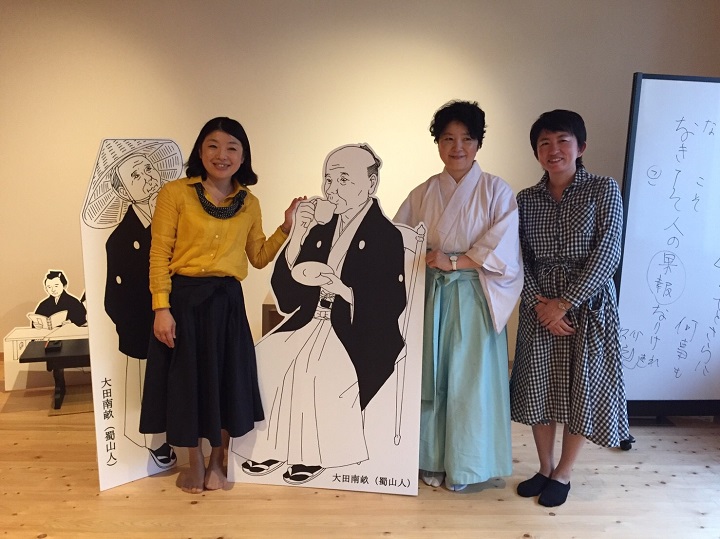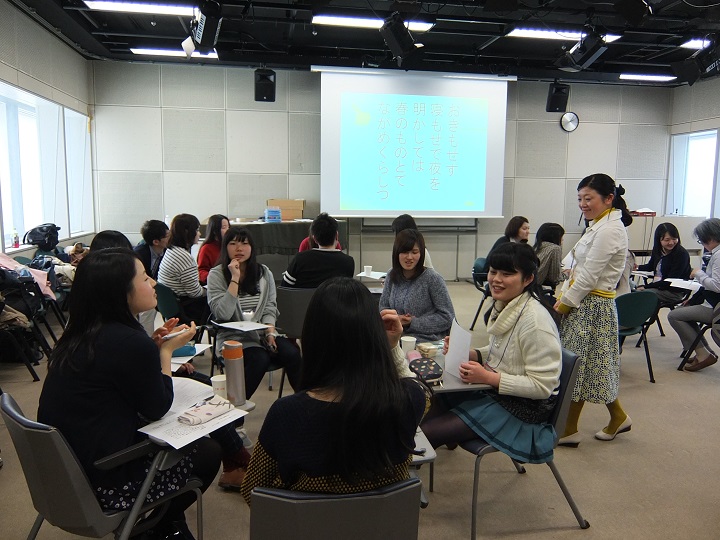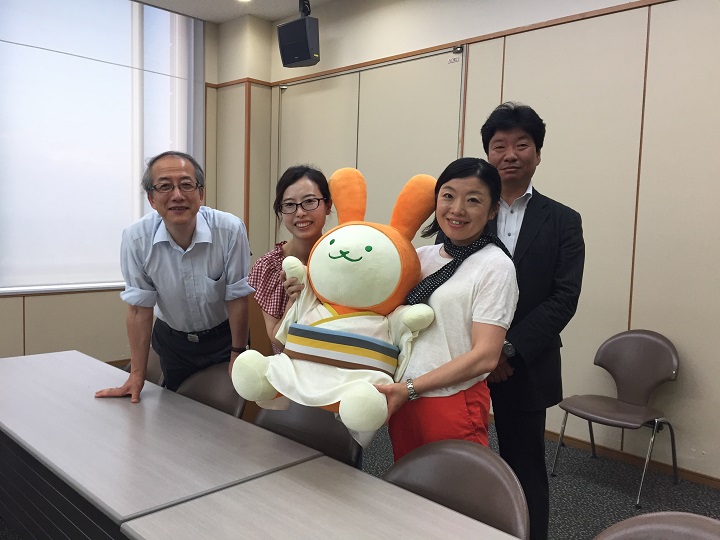reseach
Multifaceted Research on Edo Period Art and Literature
Fumiko Kobayashi, Professor
Department of Japanese, Faculty of Letters
Posted Jan.11,2023
Faculty Profile
Professor Fumiko Kobayashi’s fascination for kyōka (comic verses), gesaku (popular fiction), ukiyo-e and other forms of Edo period art and literature has led her to ever-deeper and multifaceted studies. Overflowing with affection for Hosei University, Professor Kobayashi is also closely involved in Hosei Studies—courses for Hosei students to learn about their own university—and in the university’s branding strategies.
Rediscovering the depth and dimensions of applying art and literary studies to education
My field of research is Edo period art and literature. It encompasses a broad range of subjects but I am particularly fascinated by the kyōka*1 and other literary works of Ōta Nanpo, and the world of ukiyo-e by Katsushika Hokusai and other artists.
Exploring Edo culture through its art and literature reveals the uniqueness and strengths of Edo-Tokyo the city. At the Hosei University Research Center for Edo-Tokyo Studies (EToS), I have been leading a project on investigating and communicating the uniqueness of Edo-Tokyo since AY2021.
My first assignment at Hosei University was not at the Faculty of Letters but at the then two-year-old Faculty of Lifelong Learning and Career Studies. As a member of a team dedicated to building yet unknown modes of education, I spent my days deeply engaging with students and thinking hard about the learning I could offer to students interested in career design for people of today. My communication skills built through years of Girl Scouting served me well, and I believe I did my part in encouraging deeper student learning by employing studies on the Edo period to gain a relative perspective on present-day norms.
The exploratory nature of my work at the Faculty of Lifelong Learning and Career Studies has, I firmly believe, enabled me to continuously expand the breadth of my research at my present post at the Faculty of Letters.
*1 A type of Japanese poem, kyōka are tanka—thirty-one-syllable poems that take the 5-7-5-7-7 syllable form—that deal with humorous subject matter.

Presenting a lecture in response to an invitation from a community-building project hosted by Tokiwadai Tenso Shrine, known for its association with Ōta Nanpo. I regard activities such as this as my way of practicing practical wisdom.
Questioning assumptions with historical awareness
Studies often reveal that what we assume to be cultural traditions are not necessarily heritage preserved intact from ancient times but were often created in more recent times to serve modern system of nations or societies. For instance, matters widely accepted as normal for the time may turn out to be case-specific or deviations once they are compared with written accounts from the same period, and what was once normal can become an anomaly as times change. One example is the Japanese ie (patriarchal household) system and matters associated with it such as gendered roles/sexuality and husband and wife surnames.
The ie system itself became established in early modern times but did not make it customary for a man or woman to adopt the surname of their spouse. Likewise, when a person died, their grave was often built for each individual rather than being considered in terms of ie (or family units). An adoptee succeeding to an ie was not uncommon since being related by blood was not considered imperative. As it happens, male homosexuality has been known in Japan since ancient times and was quite common especially in the Edo period. Portrayals in numerous works of literature and ukiyo-e from the period exist in ways that suggest it was not perceived as anything out of the ordinary.
Currently in Japan, however, there is prejudice toward homosexuality, and the ie system, institutionalized to serve Meiji nationalism, is often assumed to be “traditional.”
To encourage alertness to such issues, my classes discuss how things were in the Edo period specifically to convey the value of open thinking that is free of preconceived notions. This is because I wish to encourage students to look at our times from a relative point of view by learning about historical circumstances, hopefully gaining an awareness that a social structure dependent on women exclusively serving the needs of the household—in turn based solely on heterosexual marriage—is not the norm.
The study of literature enriches our minds but is not an applied science that directly serves the practical needs of society. It can, however, address challenges facing contemporary society by adopting a historical point of view, by questioning assumptions, and by communicating findings and information. I regard this as my way of practicing practical wisdom.
My next goal is to compile into book form the outcome of a symposium held to shine light on women in early-modern and modern East Asian cities. I am in the process of putting together papers from the presenters for publication before the academic year is out.

Scene from a workshop held as part of a joint investigation into active learning methods for applying studies in Japanese classical literature to the present.
Communicating the true value of Hosei University through Hosei Studies
I feel a strong sense of connection and attachment to Hosei University as if I was naturally drawn here.
The neighborhood of the university’s Ichigaya Campus, where the Faculty of Letters is situated, is not only near the birthplace of ta Nanpo but is also closely associated with many of the luminaries of Japanese literature. I commute to work as if on a daily literary pilgrimage, constantly reminded of how blessed I am to be working in a part of Tokyo with connections to Ōta Nanpo.
In 2008, I had the privilege of sitting on the newly established council, Asu no Hosei o tsukuru (lit. Building Hosei University for Tomorrow), which discussed the installation of a Hosei Studies*2 course designed to offer more in-depth learning about the university—a course I have served as a coordinator since its subsequent inauguration. The experience of teaching Hosei Studies classes has enabled me to take an active part in the university’s branding program and its strategy meetings when they began, conducting among other tasks the drafting of the Hosei University Charter.
I am also involved in the operation of events marking the 100th anniversary of the Faculty of Letters in AY2022.
My involvement in these activities is motivated by a desire to uncover the true strengths of Hosei University to as many students as possible, helping them savor their learning experience here and the joy it brings. If this has made you curious, I urge you to give Hosei Studies a try. You are sure to discover how the university was built and shaped by emotionally intelligent original thinkers who valued open discussion. I am hopeful that learning from the inside out about Hosei University will foster in students greater pride in their university.
*2 Hosei Studies is a liberal arts course (general education course) open to all students regardless of faculty. The official course title is Introduction to Hosei Studies (formerly “Hosei University: Its People and History”).

Pictured with faculty and administrative colleagues responsible for running the AY2017 Introduction to Hosei Studies course: Professor Takayanagi Toshio; Mr. Tobe, who was then section head; and Ms. Jeong, who was then a teaching assistant.
Fumiko Kobayashi, Professor
Department of Japanese, Faculty of Letters
Born 1973 in Yamanashi Prefecture, Japan. Received a BA from the University of Tokyo, Faculty of Literature, Division of Japanese Language and Literature (Japanese Literature); and a doctorate in literature from the same university’s Graduate School of Humanities and Sociology, Division of Japanese Studies, Japanese Language and Literature. Was a research fellow (DC2) at the Japan Society for the Promotion of Science; a visiting researcher at the School of Oriental and African Studies (SOAS), University of London; and a postdoctoral research fellow (PD) at the Japan Society for the Promotion of Science; and additionally held other posts before becoming a fulltime lecturer at the Faculty of Lifelong Learning and Career Studies, Hosei University in 2004. Was appointed Associate Professor at the same faculty before becoming Associate Professor, Faculty of Letters in 2011. Has served as a professor from 2014 to the present. Currently a member of the Japanese Literature Association, the Japanese Early Modern Literature Association, and the International Ukiyo-e Society.

